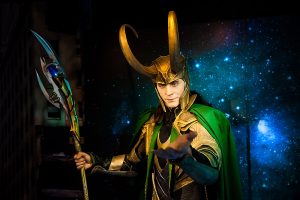The more you read on writing, the more you realize most concepts go back to a few shared sources or shared ideas. Archetypes are one of those concepts. Both Joseph Campbell and Carl Jung
discuss archetypes. They are basically a part of our collective unconsciousness. The same collective unconsciousness that makes The Hero’s Journey such a powerful tool for writers, and this definitely makes Hero’s Journey archetypes a concept worth discussing and possibly using in your own writing (with some warnings).
Archetypes Defined
For Jung, archetypes were recurring themes in character that show up in the dreams of people around the world, across cultures and across time. He also noticed that these archetypes were found in various mythological tales. Because of this, he believed these archetypes weren’t something learned. They were part of who all humans are, part of a collective unconsciousness that we are born with.
Jung’s archetypes or how he saw them, don’t correlate completely with what most writers think of when they describe an archetype. Writers think of an archetype as being a particular character whereas Jung saw more than one of these archetypes existing within any particular person for them to call on when needed. Jung also had many more archetypes than you will generally see listed as character types when discussing writing and character development for writing.
Still, though, this is the basic premise of archetypical characters in writing and Hero’s Journey archetypes.
Enter The Hero’s Journey
If you are new to The Hero’s Journey, take a little visit to my post on What is The Hero’s Journey and then scamper on back here to discuss Hero’s Journey archetypes.
All back? Okay, let’s go.
If you review the steps in The Hero’s Journey, you will see a number of archetypes/characters mentioned.

Hero’s Journey Archetypes Character List
The Hero
This first one is pretty obvious. It is The Hero’s journey after all. This must mean we need a hero. The number one quality a Hero’s Journey archetype hero must have is a willingness to sacrifice himself (or herself) to promote a greater good.
- Main character of the story/Protagonist.
- Personifies a search for identity (think of Luke Skywalker’s journey and arc in Star Wars).
- Shows an ability to grow and change.
- Drives things that happen. (Although, honestly, in my opinion, Luke fell down on the job on this one.)
- Takes the big risks.
- Has a universal appeal. (The hero’s motivation is easily understandable to readers or viewers.)
- Willingness to give something up that is important to him to complete the journey/get the elixir for others (the self-sacrifice I mentioned).
Side note: While the hero is our main character, other characters can show aspects of this archetype as well. They may not be the hero of this story, but they can become heroic and we will love them for it. (Obi Wan sacrificing himself so Luke and others can escape the Death Star.)
The Mentor
Speaking of Obi Wan… The mentor is the Hero’s Journey archetype who provides guidance and knowledge to the hero. The mentor teaches the hero and brings them along under a wing until they are ready to fly.
- Teaches hero the skills he needs to complete his journey.
- May provide the hero with gifts that will help the hero with his journey.
- May play the role of conscious to the hero. (Jiminy Cricket or the best friend in most romantic comedies)
- Motivates the hero to take on the journey. Sometimes this means pushing the hero right into the fray.
Herald
The herald lets the hero and the readers/viewers know that change is coming. They deliver the challenge or “call to adventure.”
- The appearance of the Herald is when the story really begins. The Herald archetype put the call to adventure in front of the hero for him to accept or refuse.
- The Herald does not have to be human. This Hero’s Journey archetype could actually be an act of nature, etc.
- One character may play the role of the Herald and another archetype. (Mentor and Herald are a common pair.)
- In addition to the call to adventure, the Herald may appear later in the story as well to announce some other coming change.
Threshold Guardian
The threshold guardian is an archetype who presents a challenge for the hero to overcome. He stands between the world the hero is leaving and the new world that the hero needs to enter to complete his journey. He is not the main antagonist and may even turn into an ally. Think of the dragon and his questions.
- May serve as an alarm of sorts or first barrier to protect the antagonist.
- Tests the hero’s resolve to go on this journey and his readiness.
- Getting past the Threshold Guardian provides the hero with confirmation that he is meant for this journey.
- May teach the hero some lesson that he will utilize later.
Shapeshifter
Shapeshifters shift shape. How’s that for a definition? This is the literal definition, but a Hero’s Journey archetype of shapeshifter does not have to be literal. It may be a character who appears to the hero as one type of person only to shift into a different type (reveal themselves as this other type) later. A femme fatale or fan/lover who later is revealed to be a stalker are two examples. (Could also go other way with a character who appears dangerous to the hero shifting into someone supportive, etc.)
- Represents the need to change and may elicit change in the hero as he decides how to deal with the shapeshifter. He thought he was dealing with one thing and then…
- Creates questions for the hero and increases suspense for readers/viewers.
- The hero may need to be a shapeshifter himself to get past challenges in his journey.
- Tricksters are often shapeshifters as well.
Shadow
The Shadow is also seen in Jung’s archetypes. For Jung, the Shadow is that part of yourself that you try to hide. It may be bad, but it may also be good, but not fit with the mask that you portray to the world. (Think tough guy persona who secretly writes poetry or girly girl who wants to drive a monster truck.) In the Hero’s Journey, the Shadow may be the villain or present itself in other characters including the hero himself. (Darth Vadar and his embracing of the dark side of the force being the most obvious villain representation of Shadow.)
- Shadow isn’t necessarily completely evil. (And great villains/antagonists aren’t.)
- May represent some darkness that could potentially be in the hero as well. (There but for the grace of God…)
- Because of this shared potential, the Shadow may tempt or attract the Hero to follow his path instead.
- Usually, Shadow doesn’t see himself as the bad guy. He is the hero of his own story. The reader/viewer is just seeing things from the wrong (hero’s) point of view.
- The Shadow may be inside the hero… a man-against-self story.
Trickster
Who doesn’t love a good (or not so good) trickster? The trickster is smarter than your average bear and is willing to use that intelligence against you. He may be a shapeshifter, and he is always up for some fun and mischief… possibly at cost to the hero. The trickster isn’t evil. He just is…
- Teaches the reader/viewer and possibly the hero lessons on hypocrisy and works as a catalyst for change in the story.
- Provides humor to a story.
- A Trickster may be a helper, ally, or Shadow.
- A Trickster may even be the hero. (Brer Rabbit)
- The character most likely to remain unchanged by the events of the story… or are they? How would we know for sure….? (Loki… )
So there you have it, a rundown of some of the most common Hero’s Journey archetypes. Do you have them in your story? Are you considering adding them? Time for my word of warning.
These Hero’s Journey archetypes are great to add to any story. They add that universal appeal that will add stability and a sense of knowing that can make a reader/viewer immediately comfortable. However, frequently there is a temptation to take one of the archetypes and go no further. It is very easy to take a variation of these archetypes, (for example, a mentor who is the wise old woman) and present them at face value only, to write a cliche.
Don’t do that. Take these lessons from myth and folklore and develop these archetypes into fully rounded characters with fears and goals and motivations. Make them real. (The Enneagram is one tool to help with this.)
Now back to the archetypes… which is your favorite? I’ve given a photographic hint as to mine…
~~~

Lori Devoti is the author of paranormal romance, urban fantasy and young adult fiction. Under the name Rae Davies, she writes the USA Today Bestselling Dusty Deals Mystery series. Check out her books at www.LoriDevoti.com and RaeDavies.com. Looking for help with your writing? Lori also does developmental editing and critiques for other authors and publishers. See our Editorial Services page for contact information and pricing. Or check out Lori’s classes at the Continuing Studies Department of the University of Wisconsin.

0 Comments